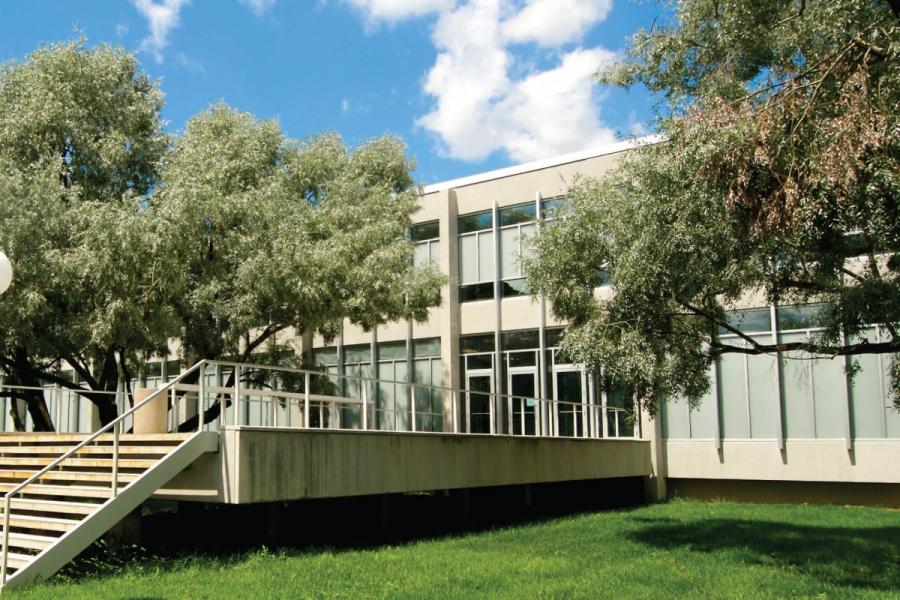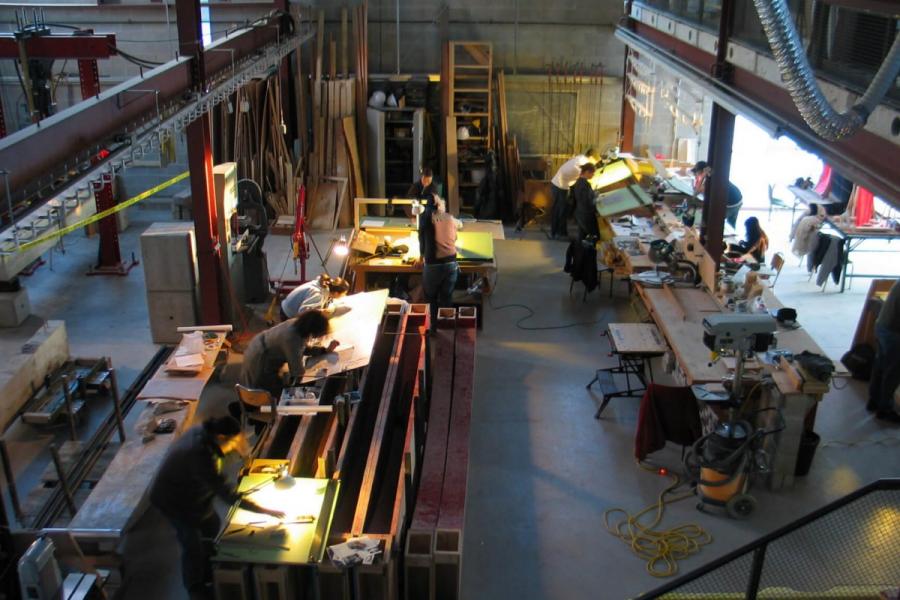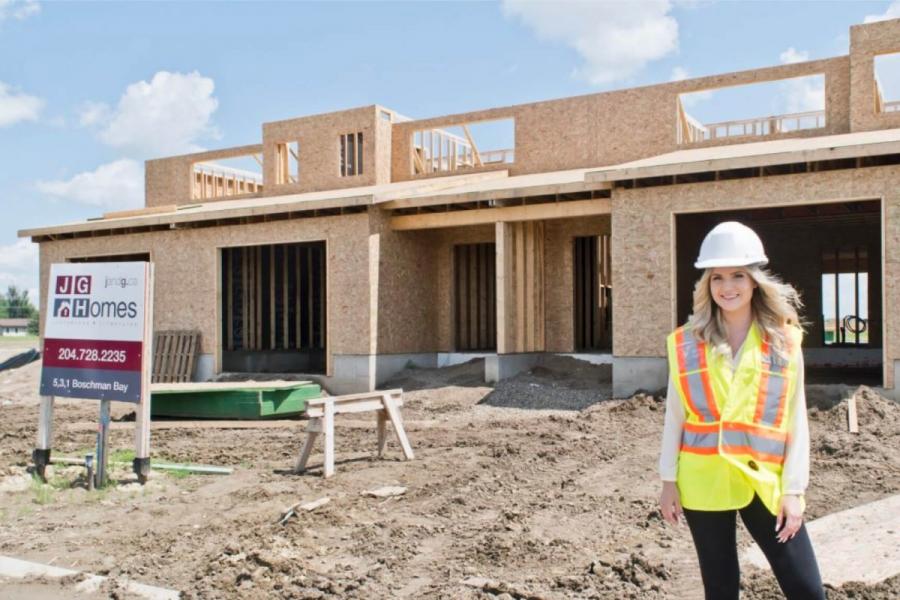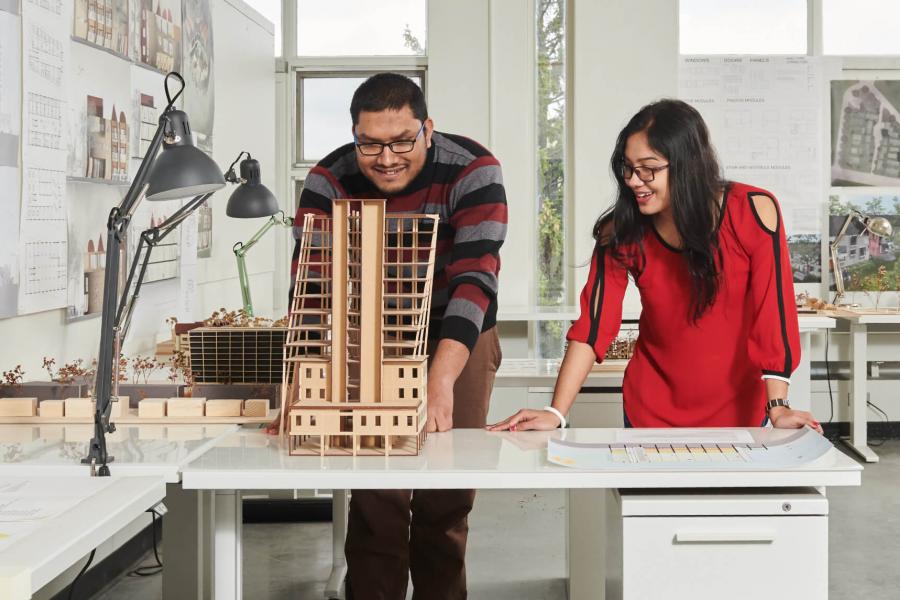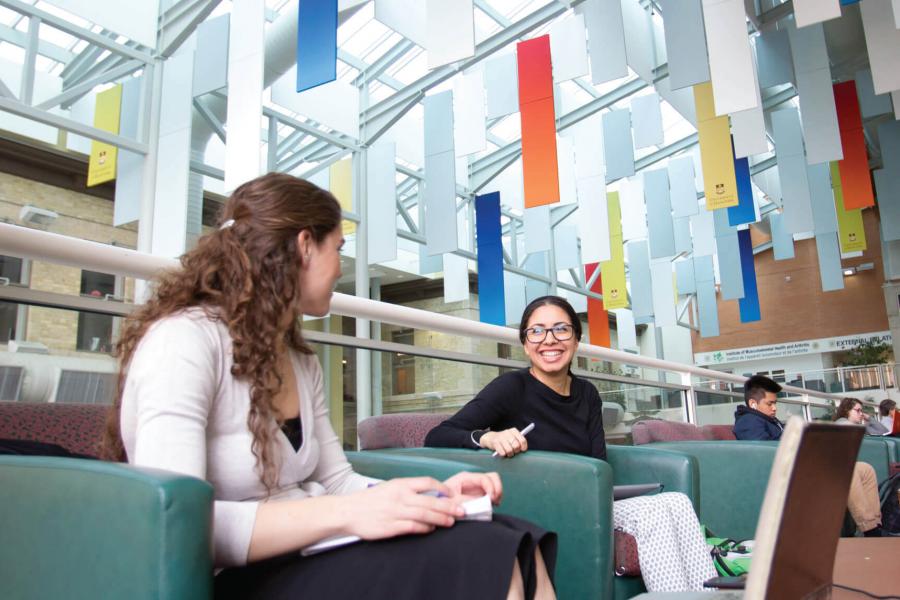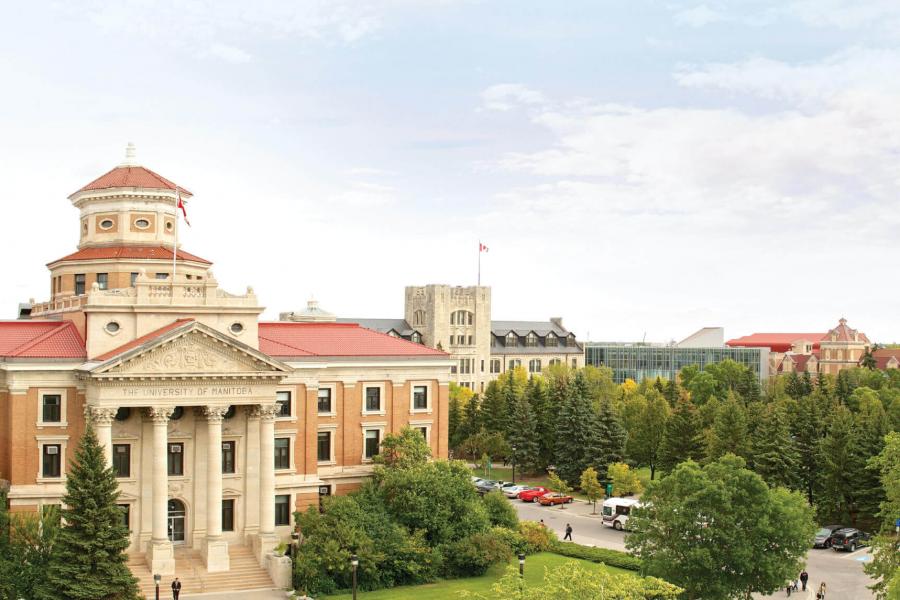
A foundational design education
Program details
The Bachelor of Environmental Design Degree (BEnvD) is a four-year program consisting of two years of common foundation studies, followed by two years of pre-professional intermediate studies in one of three areas of focus: Architecture, Interior Environments, or Landscape + Urbanism.
Expected duration: 3 years (plus qualifying year)
Years 1 and 2 of the program provide a solid grounding in the basic knowledge and language shared by all of the environmental design disciplines. Students come to understand the holistic nature of environmental design and, at an early stage, begin to establish a rich and multidisciplinary dialogue with their peers, while discovering strengths and interests relating to a particular design discipline. Years 3 and 4 provide opportunities to be challenged by academic and professional design theories and practices specific to one of three particular disciplines:
- Architecture
- Interior environments
- Landscape + urbanism
Foundation studies (Years 1 and 2) sample courses
Year 1 courses are typically completed before admission into the program.
- EVDS 1602: Visual Literacy (3 credit hours)
- EVDS 1660: History of Culture, Ideas and Environment 1 (3 credit hours)
- EVDS 1680: Environmental Technology (3 credit hours)
- EVDS 2100: Urban Media Lab (3 credit hours)
- EVDS 2200: Ecology and Design (3 credit hours)
- EVDS 2300: Materials, Structures and Assemblies (3 credit hours)
- EVDS 2400: Visual Media 1 (3 credit hours)
- EVDS 2500: Design Studio 1 (6 credit hours)
Architecture Option and ED AMP sample courses
Environmental Design Architecture Option Year 3 (ED3 Arch) and ED AMP Year 1
- EVAR 3000: Pre-Modern History and Theory I (3 credit hours)
- EVAR 3004: Architectural Technology 1: Structural and Sustainable Use of Materials (3 credit hours)
- EVAR 3008: Architecture Design Studio 1 (9 credit hours)
- EVAR 3014: Drawing: Freehand & Digital (3 credit hours)
Environmental Design Architecture Option Year 4 (ED4 Arch) and ED AMP Year 2
- EVAR 4000: Modern Architectural History and Theory I (3 credit hours)
- EVAR 4002: Architectural Technology 3: Building Systems (3 credit hours)
- EVAR 4008: Architectural Technology 4: Comprehensive Design Technology Report (3 credit hours)
- EVAR 4004: Architecture Design Studio 3 (9 credit hours)
Interior Environments Option sample courses
Year 3 (ED3 IE)
- EVIE 3002: Interior Design History and Theory 1 (3 credit hours)
- EVIE 3004: Materials, Assemblies and Detailing (3 credit hours)
- EVIE 3008: Interior Design Studio 3.1 (6 credit hours)
- EVIE 3012: Interior Light and Colour (3 credit hours)
- EVIE 3014: Human Factors and Environmental Experience (3 credit hours)
Year 4 (ED4 IE)
- EVIE 4000: History and Theory 2 (3 credit hours)
- EVIE 4006: Design Methods and Processes (3 credit hours)
- EVIE 4010: Interior Design Studio 4.1 (6 credit hours)
- EVIE 4014: Advanced Interior Design Media (3 credit hours)
Landscape + Urbanism Option sample courses
Year 3 (ED3 LU)
- EVLU 3000: History of Designed Environments (3 credit hours)
- EVLU 3002: Site Planning (3 credit hours)
- EVLU 3004: Ecology and Design 2 (3 credit hours)
- EVLU 3008: Studio 4: Networks and Infrastructure (9 credit hours)
- EVLU 3012: Site Morphology + Grading (3 credit hours)
Year 4 (ED4 LU)
- EVLU 4014: Studio 6: Emergent Futures (9 credit hours)
- EVLU 4016: History of Landscape + Urbanism (3 credit hours)
- EVLU 4002: Construction Materials (3 credit hours)
- EVLU 4008: Plants, Ecosystems and Design (3 credit hours)
For full course descriptions, please visit the Academic Calendar.
Architecture Master Preparation Option (ED AMP)
For students who already have an undergraduate degree, the Environmental Design Program's Architecture Master Preparation Option is a great way to qualify for application to the Faculty's Master of Architecture program.
Stream one (ED AMP 1: two years of study)
For students who have a recognized undergraduate degree but little or no formal design education. Upon successful completion of all the requirements for this two-year option, students will be eligible to receive a Bachelor of Environmental Design degree.
Stream two (ED AMP 2: one year of study)
For students who already have an undergraduate design degree in an allied design field such as interior design or landscape architecture or who have an Environmental Design degree in the interior environments or landscape + urbanism stream. These students may be considered on a case-by-case basis for placement into Year 4 Environmental Design Program Architecture Option, but will be ineligible to receive the Bachelor of Environmental Design degree.
Admission requirements
The following are minimum requirements for entry into the BEnvD and ED AMP programs. Meeting these requirements does not guarantee acceptance into the programs.
If you do not meet the requirements for advanced entry into the Bachelor of Environmental Design program, you may be eligible for admission to the Faculty of Arts or another program. If you have not attended university before, you can apply for a program with direct entry, such as University 1.
Degree program admission requirements
The Bachelor of Environmental Design is an advanced entry program, which means you must complete one year of university-level, including several required and recommended courses, with a minimum adjusted grade point average of 2.50, before you can be considered for admission.
Architecture Master Preparation Option admission requirements
The Architecture Master Preparation Option program requires you to already have an undergraduate degree with a minimum adjusted grade point average of 3.0 in your last 60 credit hours of university-level study to be considered for admission.
Enrolment in the Environmental Design: Architecture Master Preparation Option is competitive and limited. Students will be admitted on the basis of an annual selection process. Applicants satisfying the minimum academic requirements are eligible for consideration at the discretion of the Department of Architecture Admissions Selection Committee.
How to apply
Domestic student application fee: $100
International student application fee: $120
Applications to the University of Manitoba are completed online. To begin your application, select the Start or continue your application button. The online application includes several parts, and you may be required to submit transcripts, proof of English Language proficiency, and other documents.
As part of the application process, the following categories of applicants must submit a portfolio of previous work:
- Applicants applying for the Bachelor of Environmental Design program under Individual Consideration and Canadian Indigenous Applicant categories
- All applicants applying for the Environmental Design: Architecture Master Preparation Option
Special consideration and Canadian Indigenous applicant portfolio guidelines
Portfolios reflect design interests, inclinations, creative abilities and potential across a wide spectrum of endeavours.
A portfolio contains a comprehensive representation of the applicant’s creative achievements and potential as well as design interests. Visual and written work are both considered valuable. Since it is understood that many applicants are coming from disciplines or backgrounds that do not necessarily utilize graphic forms of communication, the contents of the portfolio are to be focused towards illustrating, in whatever way possible, your creative abilities and potential. The committee is very interested in projects that you do on your own, as well as those done for school assignments. These projects can be photographed or copied, complete with brief descriptions of each project (maximum one paragraph) to form the Portfolio.
The following list outlines different forms that this material can take:
- Written: Poetry, articles, travel journals, research papers, music, etc.
- Graphic: Photography, sketches, drawings, paintings, or technical drawings, etc.
- Constructed: Photographs, drawings, and sketches of built projects and creative works
The Admissions Committee asks that the following guidelines be used for producing a neat, clear, and effective portfolio:
- Minimum size: 8.5” x 11” to maximum size: 11” x 17” bound vertical or horizontal format.
- Name must be clearly visible on the spine.
- Quality plastic sheet protectors for each page of the portfolio are recommended.
- Supply a table of contents or consistent chapter identification with work presented in chronological order.
- A brief explanatory text (one paragraph maximum) should accompany each image and/or project. Do not include any lengthy written descriptions.
- Crediting is required for all work presented in the portfolio.
- Do not include CDs, videos, films, slides, etc. Print images from animated material (only images that have been printed will be accepted).
- Do not submit unclear or poorly reproduced photographs, reproductions or drawings. Photos should not be smaller than 3” x 5”.
Environmental Design: Architecture Master Preparation Option portfolio guidelines
Portfolio
The portfolio should contain a comprehensive representation of the applicant’s creative achievements and potential as well as design interests. Both visual and written work are considered valuable.
In the case of Environmental Design Architecture Master Preparation Option 1 Program (AMP 1) applicants: Since it is understood that many of you are coming from disciplines or backgrounds that do not generally utilize graphic forms of communication, the contents of the portfolio are to be focused towards illustrating in whatever way possible, your creative abilities and potential.
In the case of Environmental Design Architecture Masters Preparation Option 2 Program (AMP 2) applicants: You should assemble a comprehensive portfolio including creative work from both your previous studies, as well as self-initiated work.
The following list outlines different forms that this material can take:
- Written: Poetry, articles, travel journals, research papers, music, etc.
- Graphic: Photography, sketches, drawings, paintings, or technical drawings, etc. Since we primarily communicate through drawings in Architecture, it is important to include as many different examples as possible.
- Constructed: Photographs, drawings, and sketches of built projects and creative works
The Admissions Committee asks that the following guidelines be used for producing a neat, clear, and effective portfolio:
- Electronic submission (PDF maximum size of 20 MB) • Format: Minimum size: 8.5” x 11” to maximum size: 11” x 17” bound vertical or horizontal format.
- Supply a table of contents or consistent chapter identification with work presented in chronological order. Please keep any graphic layout to a minimum, as we are much more interested in seeing your work.
- A brief explanatory text (one paragraph maximum) should accompany each image and/or project. Do not include any lengthy written descriptions.
- Previous schoolwork as well as independent or self-initiated work may be included. In the case of schoolwork, include the project program issued, main objectives of project, instructors’ names, dates and duration (or briefly describe this). Also include written evaluations and grades received, where available.
- Crediting is required for all work presented in the portfolio. If group or office work is presented, clearly indicate your specific role in the work.
- Do not include CDs, videos, films, slides, etc. Print images from animated material (only images that have been printed will be accepted).
- Do not submit unclear or poorly reproduced photographs, reproductions or drawings. Photos should not be smaller than 3” x 5”.
Statement of Intent
The Statement of Intent should be a description (750 words maximum; 12 pt minimum font size) that reflects and contemplates on your interest in the field of Architecture. This is not to be a biography. Do not repeat what the CV tells us. We are most concerned with what interests you. Please be sincere and heartfelt in your responses. Your Statement of Intent should be uploaded to your application.
We offer you the following questions to assist you in this endeavour:
- What experiences have you had that may have initiated your interest in studying Architecture?
- What do you believe Architecture can offer our culture as a whole?
- What do you expect to get out of an education in Architecture?
- What are your favourite three spaces and why?
- Relate the memory of a poignant spatial experience.
- What are your favourite three books and why (not limited to Architecture books)?
Learn more
Keep exploring
Contact us
Admission and application inquiries
Mailing address
Undergraduate Admissions
424 UMSU University Centre
University of Manitoba
66 Chancellors Circle
Winnipeg, MB R3T 2N2 Canada
Office location
Room 424 UMSU University Centre
65 Chancellors Circle
University of Manitoba (Fort Garry campus)
Submit a question
Phone: 204-474-8808
Toll-free: 1-800-224-7713 ext 8808
Program inquiries
Environmental Design Program
Faculty of Architecture
201 John A. Russell Building
84 Curry Place
University of Manitoba (Fort Garry campus)
Winnipeg, MB R3T 2M6
env.design@umanitoba.ca
Phone: 204-474-6578
Fax: 204-474-7532





